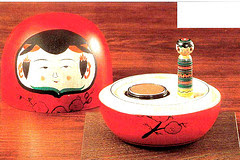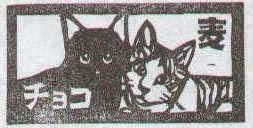[http://darumasan.blogspot.jp/]
[ . BACK to DARUMA MUSEUM TOP . ]
:::::::::::::::::::::::::::::::::::::::::::::::::::::::::::::::::::::::::::::::::::::::::::::::::::::::::::::::::::::::::::::::::::::::::::::::::::::::::::::::::::::::::::
minogame 蓑亀 minokame, "turtle with a raincoat" art motives
. WKD : Turtle (kame 亀) .
. Urashima Taro 浦島太郎 legend .
. tsuru kame, tsurukame 鶴亀 auspicious Tortoise and Crane .
. hiiki 贔屓 / 贔負 dragon "turtle" .
. mino 蓑 straw raincoat and 蓑虫 minomushi .
- Introduction -
:::::::::::::::::::::::::::::::::::::::::::::::::::::::::::::::::::::::::::::::::::::::::::::::::::::::::::::::::::::::::::::::::::::::::::::::::::::::::::::::::::::::::::

- quote -
In Japan,
the turtle has developed a more independent tradition than the other three prominent beasts of China. The minogame (蓑亀), which is so old it has a train of seaweed growing on its back, is a symbol of longevity and felicity. A minogame has an important role in the well-known legend of Urashima Tarō.
According to traditional Japanese beliefs, the tortoise is a haven for immortals and the world mountain, and symbolizes longevity, good luck, and support. It is the symbol of Kumpira, the god of seafaring people.
The tortoise is a favored motif by netsuke-carvers and other artisans, and is featured in traditional Japanese wedding ceremonies. There is also a well-known artistic pattern based on the nearly hexagonal shape of a tortoise's shell. These patterns are usually composed of symmetrical hexagons, sometimes with smaller hexagons within them.
- source : wikipedia
..............................................................................................................................................
- quote -
The Minogame in Japanese Culture
Japan is a country that has many different traditions and legends of turtles. One of its most famous is the mythological giant turtle known as the minogame (蓑亀, or 'straw raincoat-turtle' due to the tail resembling a farmer's straw coat). The minogame is regarded as a very auspicious creature in Japanese culture and has made appearances in arts, crafts, and even in modern-day popular culture!
The minogame is said to live at least a thousand years (with some living up to 10,000 years!) and have a long, hairy tail, which is actually seaweed and algae that have grown on its shell due to its ripe old age! It has very similar to the real-life common tortoise, which can live for hundreds of years. In Japanese culture, the minogame represents longevity and wisdom, and is a long-revered symbol of both. In art, it is often shown with other gods and symbols of longevity, such as the crane, or Taoist deities such as Jurōjin. The minogame is also depicted with the Three Jewels, which represent fortune.
Unlike the minogame's highly-fictitious cousin Gamera, the minogame has its basis in real-life tortoises and turtles. In fact, other than the tail and its very long life span, it's almost indistinguishable from a regular tortoise! It has been said that tales of the minogame were created from ancient Japanese watching real-life turtles in their everyday environment. While swimming around in rivers, ponds, and the ocean, turtles tend to get seaweed stuck to their shells. Hence the minogame's "hairy" tail was born! Also, according to some sources, the minogame has its origins in attempts by artists to draw turtles with seaweed stuck to their shells.
The most famous minogame in Japan is that from the legend of Urashima Taro. In some versions of the legend, a minogame, rather than a regular tortoise, is said to have taken Urashima to the Palace of the Dragon God after having rescued the smaller turtle (which was actually the princess Otohime) from the children who were tormenting it.

Print by Katsushika Hokusai (1760-1849) depicting a group of men inspecting a minogame.
The minogame has long been depicted by Japanese artists. Many have depicted Urashima Taro's famous undersea voyage, or have otherwise been inspired by it. Minogames have been the subject of sculptures, ukiyo-e prints, surimonos (color paintings), and all other kinds of art forms over the centuries, both past and present.
Just the same, Japanese artisans have made minogame crafts and toys for many centuries. Minogame dolls, candy molds, netsuke carvings, pottery and ceramics, katana (samurai swords), and other handicrafts or hand-made items have been popular in Japan for centuries. The minogame's connotations with longevity (and the fact that it's just plain cool!) make it a very popular motif on handicrafts!
In modern-day Japan, the minogame - or characters based on it - can be found in various anime and manga, tattoos, toys, and elsewhere. Of course, it can also be found where it has always been over the millinea: In the country's arts, crafts, and legends!
There are different mythological turtles in Japan, but the minogame is possibly the most interesting of them all!
- source : the-turtle-cove.blogspot - Josh
:::::::::::::::::::::::::::::::::::::::::::::::::::::::::::::::::::::::::::::::::::::::::::::::::::::::::::::::::::::::::::::::::::::::::::::::::::::::::::::::::::::::::::
. kokeshi こけし wooden dolls .

CLICK for more samples !
:::::::::::::::::::::::::::::::::::::::::::::::::::::::::::::::::::::::::::::::::::::::::::::::::::::::::::::::::::::::::::::::::::::::::::::::::::::::::::::::::::::::::::
. tsurushibina つるし雛 / 吊るし雛 small hanging hina dolls .

CLICK for more samples !
:::::::::::::::::::::::::::::::::::::::::::::::::::::::::::::::::::::::::::::::::::::::::::::::::::::::::::::::::::::::::::::::::::::::::::::::::::::::::::::::::::::::::::
. netsuke 根付 Netsuke .

CLICK for more samples !
:::::::::::::::::::::::::::::::::::::::::::::::::::::::::::::::::::::::::::::::::::::::::::::::::::::::::::::::::::::::::::::::::::::::::::::::::::::::::::::::::::::::::::
. kimono 着物 Japanese robes .

CLICK for more samples !
:::::::::::::::::::::::::::::::::::::::::::::::::::::::::::::::::::::::::::::::::::::::::::::::::::::::::::::::::::::::::::::::::::::::::::::::::::::::::::::::::::::::::::
. tsuba 鍔 sword guard .

CLICK for more samples !
:::::::::::::::::::::::::::::::::::::::::::::::::::::::::::::::::::::::::::::::::::::::::::::::::::::::::::::::::::::::::::::::::::::::::::::::::::::::::::::::::::::::::::

- source : calamel.jp/go
:::::::::::::::::::::::::::::::::::::::::::::::::::::::::::::::::::::::::::::::::::::::::::::::::::::::::::::::::::::::::::::::::::::::::::::::::::::::::::::::::::::::::::
More art motives

minogame and shells 蓑亀 蛤

mug cup マグカップ

sake tokkuri with tsuru and kame 鶴と亀 徳利
CLICK each for more samples !
- photos - minogame on pinterest -
- minogame hashtags #minogame -
:::::::::::::::::::::::::::::::::::::::::::::::::::::::::::::::::::::::::::::::::::::::::::::::::::::::::::::::::::::::::::::::::::::::::::::::::::::::::::::::::::::::::::
. Sake 酒 Jizake local rice wine .

池亀 蓑亀 Ikegame
- source : fukudasaketen.jp

神亀(しんかめ)Shinkame
- source : ebulogu.blog88.fc2.com

CLICK for more samples !
:::::::::::::::::::::::::::::::::::::::::::::::::::::::::::::::::::::::::::::::::::::::::::::::::::::::::::::::::::::::::::::::::::::::::::::::::::::::::::::::::::::::::::

sangusoku 三具足 three Buddhist altar fittings from Tsushima
鶴亀の燭台, 香炉 花瓶 - from Bansho-In 万松院
Drei Gegenstände (mitsugusoku, sangusoku)
Räucherbecken, Standleuchter und Blumenvase.
Diese drei sind die wichtigsten Gegenstände für Opferzeremonien, die mindestens auf der Altar-Plattform oder einem Seitentisch vorhanden sein müssen. In der Mitte das Räucherbecken, rechts davon ein Standleuchter und links eine Blumenvase. Diese Gegenstände bildeten schon in Indien die Grundausstattung eines Altars, aber erst in China entstand der Brauch, die drei nebeneinander auf dem gleichen Tisch anzuordnen. In Japan wurde diese Anordnung zunächst von der Zen-Sekte während der Kamakura-Zeit eingeführt und fand sich bald auch in den Hausaltären reicher Gläubiger. Später verwendete man dann die fünf Gegenstände.
. Gabi Greve .
:::::::::::::::::::::::::::::::::::::::::::::::::::::::::::::::::::::::::::::::::::::::::::::::::::::::::::::::::::::::::::::::::::::::::::::::::::::::::::::::::::::::::::

. Join the MINGEI group on facebook ! .
. Regional Folk Toys from Japan .
. Japan - Shrines and Temples .
. Tohoku after the BIG earthquake March 11, 2011
[ . BACK to WORLDKIGO . TOP . ]
[ . BACK to DARUMA MUSEUM TOP . ]
:::::::::::::::::::::::::::::::::::::::::::::::::::::::::::::::::::::::::::::::::::::::::::::::::::::::::::::::::::::::::::::::::::::::::::::::::::::::::::::::::::::::::::
--
Posted By Gabi Greve to Omamori - Japanese Amulets on 4/17/2015 09:46:00 am





































